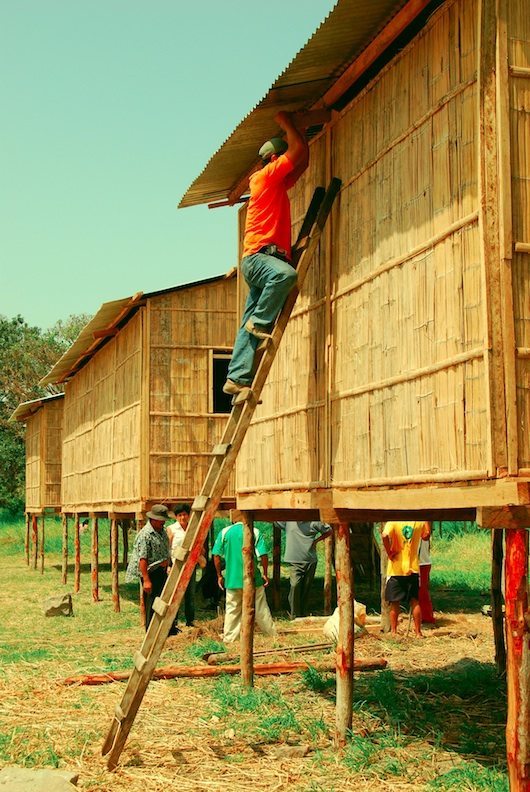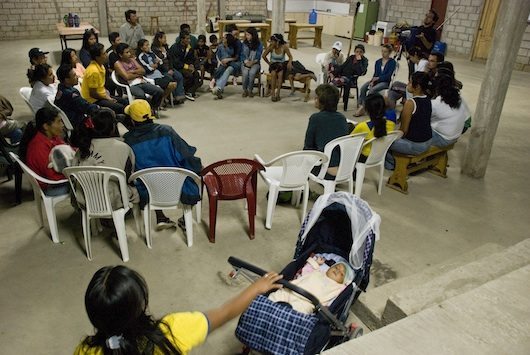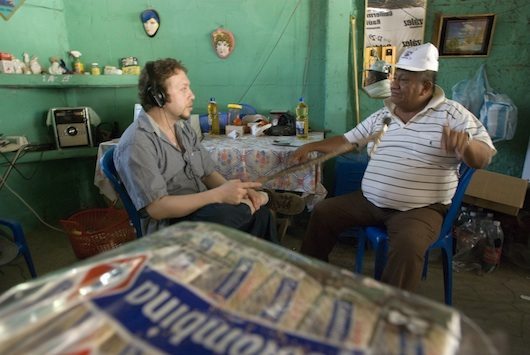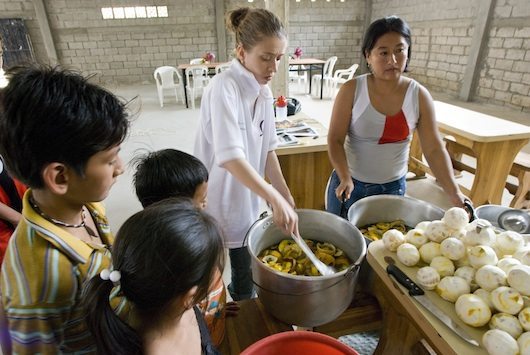Location: Guayaquil & Limoncito, Ecuador
INTRODUCTION by Lauren Elder
LARISSA MARANGONI IS A remarkable exception among contemporary artists. She is a visionary based in the port city of Guayaquil, Ecuador—not currently one of the art world’s ‘hot spots.’ She thrives there, producing eloquent, deeply psychological sculptures for museums and galleries as well as bold, elegant pieces for public art settings and individual clients. In addition to her cosmopolitan professional practice, she also directs the ‘revolutionary’ community arts residency program known as Franja Art Comunidad.
‘Visionary’ is an extravagant and over-used term, but in Larissa’s case there is no other adequate description. She comes from a family of forward-thinking and independent individuals. Her father, for example, founded APROFE, a network of family reproductive health clinics that address the well-being of the whole person, enlisting multi-disciplinary teams of providers that may include a dance therapist, a drama coach, a sports director, job skills trainers and psychologists.
Larissa’s initiative was to add art to the mix. In 2007 she began inviting teams of international artists to rural settings to respond to environmental challenges—and opportunities—specific to each setting. The 2-week residencies seek to engage villagers in fundamental ways and have been directed increasingly towards ‘solutioneering’ that has both practical and spiritual dimensions. In 2013 they undertook the restoration of an historic water reservoir, an albarrada that had been misappropriated by a shrimp farm and then abandoned. In a dry forest region much like Baja California, this was a critical action.
Larissa and I came to know each other through the Internet, initially, and then through an introduction by a mutually known Argentinian artist, Alejandro Meitin, from the collective Ala Plastica. All three of us share a sense of the urgency of environmental issues, particularly as they are lived in the Southern Hemisphere, where impacts are more immediate, the resources are scarcer, and consciousness is just gaining ground.
During the Summer of 2014 I was fortunate to advise a CCA (California College of the Arts) student team in developing a ecologically appropriate hog farm for a rural agricultural cooperative in one of Franja’s target communities. During the construction period at Tierra Fertil, Larissa and I conversed about her next challenge: to clean the highly polluted river that runs through the city of Quevedo. She does not hesitate for a moment when envisioning a massive restorative process. It is this fiercely focused assumption that ‘all is possible’ that makes her the force that she is. I hope you become equally inspired as you read on.
I. RETURNING TO ECUADOR WITH RENEWED PURPOSE
RETURNING TO ECUADOR after 10 years of studying and living in the United States was a dream come true. I was energized and motivated to start my art career. Working very hard in Ecuador, I slowly started building sculptures for private collectors and private buildings, opening my way into the local market.1
During this time, participating in artists’ residencies abroad helped me to keep in touch with my contacts and make new ones. I participated in many artists’ residencies; during my last one I came into terms with my reality as an artist and how I felt emotionally empty in some of the places where the residencies occurred.
That is when I decided to create an artists’ residency in rural areas of Guayaquil, Ecuador, and incorporate local communities in the process of creation. I was pregnant that year with my second child, after 14 years of not being a mom. A lot was going on in my life and in my mind. I was working on obtaining my Master’s degree in Public Health because I was working for APROFE,2 an organization that focuses on sexual and reproductive health—and I needed the degree to continue my work there.
My last experience at a residency in the United States was extremely thought provoking. I was pregnant, working alone in a studio (a policy of the organizers), with no loud music allowed. This rule was understandable for artists that do not have time during the year to create, but it was not what I was expecting.
In five days I had finished a big sculpture and drawings, and I still had 10 more days to go. I wanted to leave, even though I had made good friends, walked a lot, and played ping pong. An Amish community was nearby, and every time I saw the Amish I wanted to experience them and get to know them. Days passed by, and I left realizing that I wanted to be with another community, but not the one I was supposed to be embedded with. When I returned to APROFE, my not-for-profit organization, they had a program in place that was oriented to social and health development, so I suggested including art as part of the process of achieving whole health. By unifying health, environment, art, and economic development, we can reach ‘good living’ in a shorter time.
II. GUAYAQUIL, FIRST RESIDENCY
THE CITY OF GUAYAQUIL IS surrounded by estuaries and rivers: one is in front of the downtown area, dividing our city from a wonderful place called Santay Island, now the biggest lung of the city with mangroves, trees, and elevated walkways that one can enjoy by bike, walking, or jogging. At that time, in 2006, the only way to get there was in a boat or canoe; now through the vision of Ecuador’s president, a pedestrian and biking bridge has been built, along a route of more than 14km.
In 2006 we started our first residency, ‘Solo con Natura,’3 on Isla Santay. Two of my friends, a biologist and (at that time) the director of the municipal museum, and I decided that the purpose of the residency would be to give visibility to the island and its 200 inhabitants. Fishing was their only economic resource. The community´s living conditions were very precarious, and a residency would create new possibilities for jobs, in this case in tourism.
We invited seven artists—Hernán Zuñiga, ‘Pelikano’; Adrian Washco, ‘Inventory’; Juan Carlos León,’ Parterre’; Kim Waale, ‘Speaking with Valentino’; Mary Giehl, ‘Vestibles’; Christobal Proaño, ‘Encounter’; and Katya Cazar, ‘Carpe Diem’—two North American artists and all the rest Ecuadorean. The idea behind the residency was that all of the artists would live for 10 days within the community, making art, with the local inhabitants helping the artists, creating friendships with them, and learning from one another.
The logistics of the event were enormous and required bringing all supplies for cooking and the artists’ working materials by boat.
III. BUILDING FROM SCRATCH
A RELIGIOUS GROUP, WHICH HAD been volunteering there a few years before we arrived, helped build the dining area out of caña guadua (a type of bamboo). We installed a full working kitchen that was managed by the local women and organized them in groups so all could get equal pay. A private company gave us money to build the four caña houses where the artists stayed.
IV. THE FIRST PROJECTS
ALL THE PROJECTS WERE UNIQUE and completed with love and dedication; one of the requirements was that the projects must be perishable so as to not disturb the natural cycle of the island.
After the residency many questions were brought up, such as: Why were community members limited to watching and helping and did not receive more tangible benefits than just an experience? Most of the artists created tight bonds with their assistants, but not enough to ensure continuity of some of the projects during the rest of the year.
Two of the artists taught community members to make paper out of the leaves of some of the native plants to enable them to produce objects to sell to the tourists who visited the island. However, they did not continue doing this, and neither did we.
V. LEAVING WITH QUESTIONS
RESIDENCIES IN A WAY ARE A one-time experience, and the question is: Why should the residencies benefit the artists more than the community? The last night before the end of the residency, all the artists got together with the community and sang, drank and cried. The presentation of the artists’ projects took place the next day, with everyone exhausted, emotionally drained, and leaving with more questions than they had come with. Some of the artists did not take the boat back to the city because they wanted to stay with their friends a bit longer; however, unfortunately they had to leave at some point during that day.
VI. ART COLONIZERS?
THROUGH SUCH RESIDENCIES, are we acting as ‘artist’ colonizers? Are we using the local territory and the community as a springboard for our own research? What benefit do we leave for the community? Do we have a responsibility to stay in the community longer and see if art can be a vehicle for change? Are we interfering with the community’s living process and culture?
VII. THE SECOND RESIDENCY
FOR OUR SECOND SOLO CON NATURA residency, we made a sharp turn in concept and goal, incorporating the community in the art process and in the collaborative thinking process of making art. The residency took place in 2008 in Limoncito, Ecuador.
VIII. CHANGES AND CHALLENGES IN LIMONCITO
LIMONCITO IS AN AGRICULTURAL TOWN one hour from Guayaquil. Around 400 people live there, growing corn and vegetables, and raising farm animals for local consumption. We chose this location because APROFE´s health brigade was providing services there. The idea was to not replicate Santay´s experience in Limoncito. We wanted to work more closely with the community and make this small town visible to the local government because of the shameful conditions of the area’s side roads, which made it very hard for the residents to transport their products to the main highway. Our residencies in many ways helped small towns find solutions to their basic needs—in Limoncito´s case, the issues were their roads and drinking water.
When we arrived in Limoncito for the residency we realized that our work there was going to be very hard. Our coordinator at that time was MarÃa Fernanda Cartagena, who embedded herself in the project, not only selecting the artists but really focusing in the changes that were needed for the second residency. The president of the commune was fantastic in many ways—not only with APROFE´s brigade who were there to conduct health examinations and pap smears—he also was receptive to our idea of living as part of the community and staying there for 10 days.
IX. CHANGING LOGISTICS
THE LOGISTICS OF THIS residency were very hard, because even for APROFE´s team it was difficult to understand what really we were going to do. Art? For what purpose in this small town? The induction, as I call it, was a learning process for all of us, because we had to socialize the project again in the same way we had had to do in Santay, but this time we wanted the community to be more involved and left with a product. The idea that only the artists experience a new place and a new process was not enough for our group. The local history and tradition were to be the main focus of the residency. Every residency had to be different, and each residency in each new territory had to be focused on the community’s benefit rather than for the artists’ benefit. This final point was a high point of discussion in the next residencies to come.
Our process of entering a new territory in the cases of both Santay and Limoncito was through APROFE´s health brigades. The communities trust APROFE. For more than 40 years, APROFE has been carrying out medical and educational activities in marginal urban and rural areas in Guayas Province, with the goal of improving the health and environmental hygiene of the inhabitants. APROFE’s activities are executed by medical brigades, a mobile unit, and educators in support of the communities who request their help. The brigade consists of a doctor specializing in reproductive health, a driver-motivator, and a nurse’s aide. Talks are given to inform the people about the importance of family planning, the prevention of sexually transmitted diseases, hygiene, and nutritional practices for a healthy life. We understood that to be able to obtain community approval we would need to start with APROFE´s intervention, and then meet and make a presentation to the authorities of the territory in which we wished to intervene.4
X. MEETING BASIC NEEDS
WE REALIZED THAT EACH territory is unique, and therefore personalized methodologies would need to be created for each residency developed in a different location. Santay’s residency had received sufficient attention from different governmental authorities to enable the community´s basic needs to be solved at the time of our first residency. The government began taking care of the community and our help was no longer needed. APROFE as a result packed their bags and left.
XII. MOVING FORWARD
IN RECENT YEARS, WITH THE investment of the government, Santay Island has become a ‘must visit’ place in Guayaquil. A bridge now connects the continent to the island, and a floating walkway brings visitors directly to the eco town. However, Limoncito is another issue. While the change in goals for this residency kept the focus on the community, we ended up leaving Limoncito because the local authorities wanted us to pay them to allow us to be there, even though during our time there we provided health care and helped build a communal center and made other improvements. Imagine some of the projects we executed there—some were about making visible artworks, others focused on performance, and another focused on making a liquor similar to limoncello called limonacho.
XIII. MAKING ART IS NOT ENOUGH
WHILE AT TIMES CHALLENGING, these residencies, the first in Santay and the second Limoncito, helped us understand that making art is not enough. When one goes from inside to outside, especially with the participation of a community, art becomes a vehicle of change and not just an action, intention, or idea. Our experience over nine years, with three additional residencies accomplished in Ecuador to date5, has been very productive and positive, allowing us to analyze our art making and art practices and how important it is to continue intervening in new territories of art and community.
END NOTES
1 See www.larissamarangoni.com.
2 Asociación Pro Bienestar de la Familia Ecuatoriana (Association for the Welfare of the Ecuadorian Family). See www.aprofe.org.ec.
3 See www.soloconnaturaecuador.org.
4 See https://www.youtube.com/watch?v=L05UOYYMybg and https://www.youtube.com/watch?v=Apq27nZRmTE.
5 Solo con Natura has continued to organize artists’ residencies in Ecuador. Since the first two residencies (at Santay and Limoncito), Solo con Natura has presented residencies in Puerto El Morro (2009), Engabao (2011), and El Morro and Puerto El Morro (2013). See www.soloconnaturaecuador.org for more information.











